Dear Dr. Zoomie, how is radiation detected and measured?
Great question – and very important. Since we can’t sense radiation ourselves, our instruments are the only things that make it possible for us to know if we’ve got potential problems. In fact, you can be in a dangerously high radiation area and still have no way of telling you’re at risk unless you have radiation instruments.
OK – so we need our instruments, but you can’t just go out and buy the first radiation detector you see. There are a bunch of different types of radiation instruments – some measure radiation, some measure contamination, some are specialized to detect only one type of radiation, and some are designed to identify exactly what kind of radioactive materials you’ve found. So let’s talk a little bit about each of these.
Measuring radiation dose rate
If you’re trying to keep yourself safe – to keep from getting radiation sickness for example – you’ll be interested in measuring radiation dose rates. These are measured in units of mR/hr (in the US) or mGy/hr (in the rest of the world).
Although most people think of Geiger counters when they think about measuring radiation, Geiger counters aren’t always the best instruments to use for measuring radiation dose rate. In fact, the run-of-the-mill Geiger counter is going to give you a reading that’s too high most of the time because it will over-respond to the low-energy gamma rays that make up most of the natural background radiation. On the other hand, if you’re trying to measure radiation from high-energy gamma rays (like those given off by radioactive cobalt-60) a Geiger counter will read too low. There is one specific type of Geiger counter that’s good for measuring radiation dose rates – it’s called an “energy-compensated” Geiger counter. Unless you have one of these you should avoid measuring radiation dose rates with a Geiger counter.
The best way to measure radiation dose rates is by using an instrument called an ion chamber (or a pressurized version designed to measure very low radiation dose rates). These instruments are made up of a chamber filled with gas – when radiation passes through the chamber it changes the electrical properties of the gas. We can measure these changes and they tell us how much radiation the instrument is being exposed to.
Measuring radioactive contamination
Even if the radiation dose rates are low you might still have radioactive contamination. As one example, when I traveled to Fukushima shortly after the reactor accident I was in some areas in which radiation dose rates were nothing to worry about, but I could still measure contamination from radioactive cesium and iodine. The areas where I was traveling were not inherently radioactive, but radioactivity had settled there from the accident. Contamination can be cleaned up, just as we can clean up a dirty surface or we can clean grease from our hands after we work on an engine. Geiger counters are great for measuring contamination – in fact, a type of Geiger counter called a “pancake GM” is one of the best things around to measure it. So Geiger counters might not be the best things to measure radiation dose rate, but they’re just the things to have for measuring contamination. Oh – we measure contamination in units of “counts per minute” that are abbreviated CPM.
Measuring different types of radiation
Once we get past the different types of measurements (dose rate and contamination levels – or count rate) we have to contend with the fact that there are four different kinds of radiation; alpha, beta, gamma, and neutron. Each one of these has different properties and each of them is measured somewhat differently. This isn’t the place to get into each of the types of radiation, although that might be a good topic for a later posting. Rather than going into a long discussion of each type of radiation detector it might be easier to summarize them in a table.
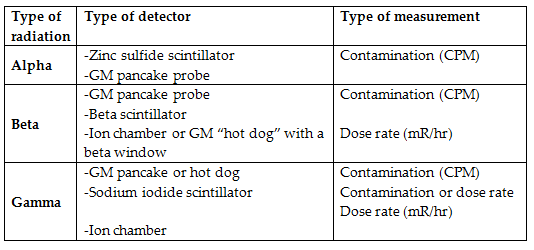
Measuring neutrons is not easy and most neutron detectors are expensive. Luckily there are very few times we have to make neutron measurements – mostly around nuclear reactors – so we won’t talk about neutron detectors here.
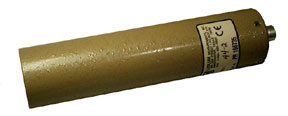
Sodium iodide (NaI) probe for gamma contamination and radiation surveys. This should be used for contamination surveys unless it is attached to a meter that has been calibrated to measure in radiation levels (this information should be noted on the instrument calibration records. Record results in CPM.
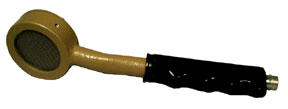
Geiger-Mueller (GM) “pancake” probe for beta and gamma contamination surveys. Record results in CPM.
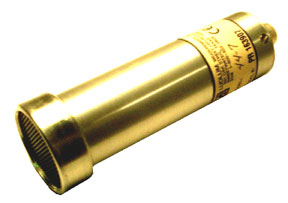
Geiger-Mueller (GM) “hot dog” probe for beta and gamma contamination surveys. This may be used for measuring radiation levels only if the meter was calibrated for the isotope (e.g. Cs-137) present. Record results in cpm.
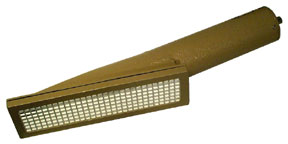
Zinc sulfide (ZnS) alpha scintillation probe. The window on this probe is exceptionally fragile and must be protected from accidental puncture. Record results in cpm.
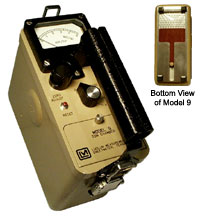
Ion chamber. This detector is used to measure radiation levels from beta (with bottom window open) or gamma (with bottom window closed) radiation sources. Record results in mr/hr.